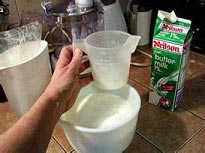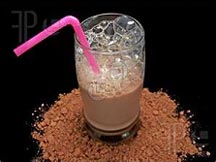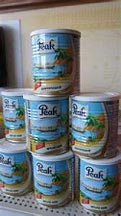Patty's Preparedness Corner: Powdered Milk
By Patty Liston
 (Put your feet up and settle in. This is a longer than usual article, but when you are through reading it, you won't be able to say you don't know about powdered milk!)
(Put your feet up and settle in. This is a longer than usual article, but when you are through reading it, you won't be able to say you don't know about powdered milk!)
 I know. I know. Anytime someone mentions powdered milk, there is a natural gag reflex followed by a rolling of the eyes. I get it. Powdered milk has gotten a bad rap and maybe rightfully so. Once-upon-a-time, this white liquid left clumps of undiluted milk powder in your mouth, and tasted like, well, white water. Fortunately, the process of making powdered milk has come a long way since these childhood experiences.
I know. I know. Anytime someone mentions powdered milk, there is a natural gag reflex followed by a rolling of the eyes. I get it. Powdered milk has gotten a bad rap and maybe rightfully so. Once-upon-a-time, this white liquid left clumps of undiluted milk powder in your mouth, and tasted like, well, white water. Fortunately, the process of making powdered milk has come a long way since these childhood experiences.
Powdered milk is a manufactured dairy product that is made by evaporating milk to a dry consistency. This preserves the "milk" for a longer shelf life that does not require refrigeration. The finished product ends up costing half as much as "fresh" milk, has zero cholesterol, zero fat, and is high in calcium, vitamin D and protein. This is all well and good - actually, very good - but what about making it part of your food storage plan?
Something I wrote awhile ago holds true: store what you eat and eat what you store.
In other words, don't purchase what you are not already eating as an individual or family. If milk is not part of your daily diet, then storing it, and getting used to it, will be pointless. That said, powered milk can be used in a variety of ways that you may not have thought of, so having some on hand is a good idea.
Recommended Quantity to Store Unlike other provisions, milk is a little different. The question you need to ask yourself is "how much milk do I use in a week?" When figuring this out, don't forget to calculate putting milk in coffee or tea, in recipes, on cereal, by the glass, etc.
 One 10# can of milk will make approximately 4.75- 5 gallons, or @ 80 - 1 cup servings. You do the math and approximate how much you or your family would need for 1 month, then add on from there.
One 10# can of milk will make approximately 4.75- 5 gallons, or @ 80 - 1 cup servings. You do the math and approximate how much you or your family would need for 1 month, then add on from there.
 Taste
Someone did an unscientific taste test using 10 popular dried milk products. While this is by no means definitive, the best tasting products scored a 4, with several coming in at 1. It would be unfair of me to comment on any particular product, so I will just post the findings.
Taste
Someone did an unscientific taste test using 10 popular dried milk products. While this is by no means definitive, the best tasting products scored a 4, with several coming in at 1. It would be unfair of me to comment on any particular product, so I will just post the findings.
Best tasting in no particular order:
Country Cream: (www.CountryCreamMilk.com). This company will send you a trial packet of their product for you to taste prior to purchasing.
Morning Moos: Auguson Farms (www.AugasonFarms.com)
Provident Pantry: formerly Emergency Essentials, now Be Prepared, (www.BePrepared.com)
Powdered milk tastes best if it is mixed up and allowed to chill overnight before serving, or for at least 4 hours. Chilling actually aids in dissolving the powdered milk completely and gives it a fresher flavor. One web-site suggested adding 1/2 teaspoon of vanilla to every 1/2 gallon of milk for taste. Of course, adding chocolate or strawberry syrup doesn't hurt either! Just be sure you have some on hand.
Reconstituting Your Milk (from HillbillyHousewife.com)

The table above will help you work out the amount of powdered milk you will need to prepare a specific measurement of liquid milk. The following are some tips to help the milk turn out as fresh tasting as possible:
Fill your pitcher or container with half the amount of water you will be using. Measure in the appropriate amount of dry milk powder. Stir to dissolve. Fill the pitcher with the balance of the water called for above. Stir again and chill.
Use cool water when possible. The powder tends to dissolve more readily in cool water.
Stir the milk a lot, to dissolve the milk powder. Then let the milk sit for a little while and stir again. The protein in the milk powder blends most easily if it gets a chance to stand after mixing.
Other Uses:
As I mentioned at the beginning of this article, powdered milk can be used in a variety of ways that you may not have thought of. Here are some additional uses.
 Overnight Buttermilk: To make your own buttermilk, you have to start off with 1/2-cup of fresh, store-bought buttermilk and a quart (4-cups) of reconstituted milk. Combine the fresh buttermilk and reconstituted milk in a pitcher or jar. Mix it really well. Allow it to stand at room temperature overnight, or for about 8 hours. The milk will have thickened up and cultured into regular buttermilk. Refrigerate or chill and use anywhere fresh buttermilk is called for.
Overnight Buttermilk: To make your own buttermilk, you have to start off with 1/2-cup of fresh, store-bought buttermilk and a quart (4-cups) of reconstituted milk. Combine the fresh buttermilk and reconstituted milk in a pitcher or jar. Mix it really well. Allow it to stand at room temperature overnight, or for about 8 hours. The milk will have thickened up and cultured into regular buttermilk. Refrigerate or chill and use anywhere fresh buttermilk is called for.
Easy Evaporated Milk: To make this you only need dry milk powder and water. Measure 1-1/3 cups water into a jar or bowl. Add 1 cup of instant dry milk powder. Stir or shake to combine. This is the equivalent of a 12-ounce can of evaporated skim milk. To make evaporated whole milk, you will need to add some fat to replace the milk fat in whole milk. Do this by preparing evaporated skim milk and then adding 2-tablespoons of vegetable oil to the milk. Stir it up vigorously to emulsify the fat with the milk. It will separate on standing, so mix it really well right before using it. This is best used in cooking and baking. A spritz of nonstick spray will help the emulsification process.
Sweetened Condensed Milk: On the stove, bring to a boil 1/2-cup of water, 1-cup of sugar and 3-tablespoons of margarine or shortening. Add a dash of salt. Stir the mixture every now and then. When it comes to a full rolling boil, remove it from the heat. Allow it to cool slightly. Add a cup of instant dry milk powder. Use a whisk to stir it smooth. A fork or a spoon will not work out all the lumps. You really need a whisk, or egg beaters. There, you are done. This is the equivalent of a can of sweetened condensed milk. This will keep unrefrigerated for a day or two because of the sugar. I have never kept it longer than that without refrigeration. In the fridge it will keep for 2 weeks. For longer storage than that, I freeze it.
 Quick Whipped Topping: This recipe is best made if you have electricity. Put 1/2-cup of water into a large bowl and place it in your freezer. When ice crystals form around the edges remove it from the freezer. Add 1/2-cup instant dry milk powder. Whip the mixture with electric beaters until it is light and fluffy. This will take a couple of minutes. Add 2-tablespoons sugar, 1-teaspoon of lemon juice, and 1/2-teaspoon of vanilla. Beat until thick enough to spoon like whipped topping. Use immediately.
Quick Whipped Topping: This recipe is best made if you have electricity. Put 1/2-cup of water into a large bowl and place it in your freezer. When ice crystals form around the edges remove it from the freezer. Add 1/2-cup instant dry milk powder. Whip the mixture with electric beaters until it is light and fluffy. This will take a couple of minutes. Add 2-tablespoons sugar, 1-teaspoon of lemon juice, and 1/2-teaspoon of vanilla. Beat until thick enough to spoon like whipped topping. Use immediately.
Molasses Milk: High in iron, with a caramel-toffee flavor this hot beverage is quite delicious. Heat 3/4-cup of reconstituted milk in a cup in the microwave. Stir in a spoonful of molasses. Serve hot. My kids love this stuff.
 Chocolate Milk: Fill a cup with reconstituted milk. Squeeze in a couple spoonfuls of homemade Chocolate Syrup. Stir to combine.
Chocolate Milk: Fill a cup with reconstituted milk. Squeeze in a couple spoonfuls of homemade Chocolate Syrup. Stir to combine.
Storing Your Dried Milk
 Most dried milk for storage will come in a #10 can, vacuum sealed. These cans can last up to 12 years. But remember, you should be using what you store and replacing the items as you use them.
Most dried milk for storage will come in a #10 can, vacuum sealed. These cans can last up to 12 years. But remember, you should be using what you store and replacing the items as you use them.
Dry milk products are especially sensitive to storage conditions, particularly temperature and light. Vitamins A and D are photo sensitive and will break down rapidly if exposed to light.
The area where your dry milk is stored should be kept as cool as possible. If it is possible to do so, air-conditioning or even refrigeration can greatly extend the nutrient shelf life.
If the storage container is transparent or translucent then it should be put into a second container opaque to light or stored in a dark room.
Dry milk will absorb moisture and odors from the air so storage containers should be impervious to both air and moisture. The dryer it can be kept, the better it will keep. Oxygen also speeds decomposition. Powdered milk canned with nitrogen or carbon dioxide to replace air (which contains oxygen) will keep longer than powdered milk exposed to air. Vacuum canning also decreases the available oxygen.

